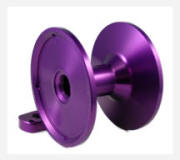The Anodizing Process
The Anodizing process begins by immersing the work in a series of solutions where various operations are performed. The solutions are held in open top tanks and the work passes through each unit. The work usually consists of distinct items that are placed on special racks and carried through the process in batches.
A multiple-step process that includes:
Cleaning removes fabrication oils and buffing compounds by soaking the work in a water-based solution containing mild acids or alkalis along with dispersants and detergents.
Pretreatment used for decorative purposes to improve the appearance of a surface prior to the anodizing step. The most common pretreatments are etch, which imparts a satin, matte finish; and bright dip, which impart a bright, shiny finish.
Anodizing produces the actual coating. Acting as the positive electrode, a direct current is passed through the item to be anodized while submerged in a bath of water and acid (sulfuric, chromic, phosphoric) used as the electrolyte. The range of colors can be expanded by over-dyeing the organic dyes, offering even more color versatility.
The water breaks down, liberating oxygen at the surface of the item, which then combines with the aluminum to form the coating a transparent and microscopically porous layer of aluminum oxide. Thickness is determined by the level of electrical current and the length of time it is applied.
Coloring - is an option approach.
Sealing the pores on the surface of the finished pieces need to be closed before the anodized item is placed into service. If left unsealed, surfaces could have poor corrosion resistance, or absorb unwanted stains. Items that are not colored during or after anodizing retain the natural color of the metal.
LNL Anodizing provides aluminum anodizing that yields durable, long-lasting coatings, with the beauty and luster of the natural metal shining through, while providing a lifetime of protection. Our experienced and highly trained specialists can help get your anodizing project off the ground, and into production. So give us a call today. The results we achieve will astound you!
Other Services
Precision masking or corking preparation Thickness verification Abrasive
Cleaning Glass Bead and Oxide Blasting Etch for Weld Duplex Seal Anodizing
Raw aluminum left exposed will corrode and oxidize.
Anodizing is an electrochemical process developed more than 50 years ago that forms a protective coating of aluminum oxide on the surface of the aluminum.
It becomes part of the
aluminum therefore it cannot peel or flake.
The coating is non-toxic.
Anodizing provides for lower maintenance cost combined with lower initial
finishing costs for substantial savings and greater long-term value.
The process may by colored by dyeing or may exhibit bronze tones through diffraction phenomena produced by the aluminum oxide. The microscopic structure of the anodized part consists of many small hexagonal pores which are filled with a sealer that hydrolyzes the pores to create a smooth, durable surface. Anodizing gives aluminum a deeper, richer metallic appearance than is possible with organic coatings. After many years, anodized surfaces may accumulate dirt and stains that look similar to chalking paint. This chalk can be removed with a mild detergent combined with an abrasive cleaning technique. A small amount of the anodic coating can actually be removed, leaving behind a renewed anodized finish which can last for another twenty years. Once an organic coating has failed, the only options are to re-coat the surface with another paint or replace the metal.
Different alloys require variations in processing. The racking of parts must provide sufficient contact areas for current transfer. These contact points are usually visible after anodizing. Its important to inform us of the alloy and preferred contact points.
Anodizing emits no ozone depleting solvents (VOCs), and there are no heavy metals involved in the process.
Electroless Nickel
Electroless Nickel is a process that can impart a decorative, corrosion resistant surface to a variety of substrates.
It is an autocatalytic process which deposits the same thickness over the complete part.
No pre plate fixturing is required.
Since the process does not require electrical current the dog-boning which occurs in hardchrome is not an issue.
Typical thickness ranges from .0002 to .002
Non-porous
Gray metallic color which may be brushed to match stainless steel
As deposited at LNL Electroless Nickel has a Rockwell hardness of C40-C45 which
can be increased to above C-60 by baking at 650F.
Metals which may be plated: stainless steel, brass, copper, steel, aluminum, and lead.
Indicate the thickness or hardness your job requires and we will be capable of
satisfying you needs.Go back up to Processes
Passivate
Passivation is the cleaning operation for castings, stampings, and machined
parts.
Passivation removes free iron contaminates left behind on the surface of steel
during machining or fabrication.
These contaminates are potential corrosion sites that result in premature corrosion and ultimately result in the deteriation of the part.
Passivation facilitates the formation of a thin transparent oxide film that protects the steel from corrosion.
Widely used for sterilization in the medical, food industry, aerospace, architectural, and many other fields.
Passivation is not designed to remove any discoloration in the part.It is important for our customers to identify the type of steel to be passivated. Our quality control processes provide for the careful solution control including: water purity, ppm of metallic impurities, and the chemical maintenance which is crucial to the passivation process.
Ultrasonic Cleaning
Chem Film
Also known as: Chromate Conversion Coating, Iridite, and Alodine.
Chemical Conversion Coating offers an excellent corrosion resistance, does not
inhibit the electrical conductivity of metal, and provides an excellent base for
the adhesion of paint.
Chemical Conversion Coating is a good choice when electrical conductivity is required, it can be used as part of an electrical circuit, or the interior of electronic chassis and critical specifications for aerospace.
The coating is specified by our customers and can vary from almost clear to an
iridescent gold. Electrical resistance increases with the darkness of the gold.
Exposure to temperatures in excess of 150 may cause damage to the film.
Variegated colors are normal and are a result of physical variations in the
metal surface.
Used in automotive components, electrical equipment, aircraft components, and
any aluminum part which requires a good paint adhesion.
Bright Dip on Brass and Copper
Our customers may create a uniquely frosted finish while removing burrs by combining heavy etch with bright dip.
Copper Plating
Copper plating offers an approved stop off for parts that require nitrate in
designated areas. It can be buffed to a highly reflective surface or grained for
a satin finish.
Bright Acid Tin
This is an electro deposited coating that offers an excellent surface for joining dissimilar metals together through the use of solder. As plated the surface is a bright, highly reflective non oxidizing finish.
Electro Polish
The SUMMA Process: This is a chemical polish for stainless steel alloys.

